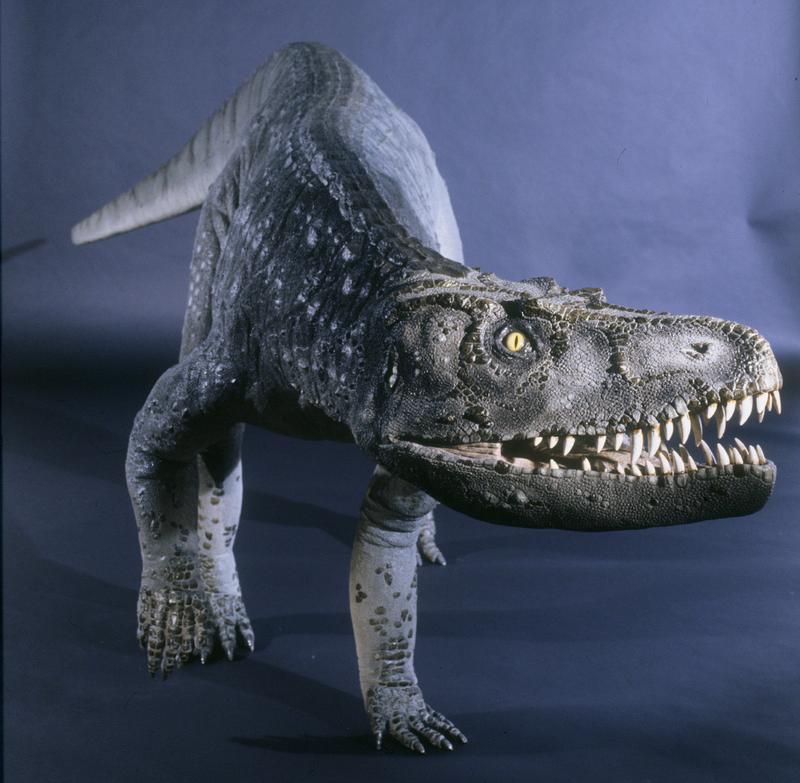The menu of a prehistoric predator
A team of scientists from the Natural History Museum in Stuttgart and the Universities of Hohenheim (Stuttgart) and Fribourg (Switzerland) have deciphered the feeding habits of the extinct reptile Batrachotomus kupferzellensis.
Batrachotomus was the apex predator of its ecosystem and belonged to the most dangerous group of animals of its time, the pseudosuchians. By analyzing hundreds of fossilized bones and teeth, the researchers were able to show that this top predator from southwestern Germany subsisted on scavenging, hunting and even cannibalism. Until replaced by carnivorous dinosaurs, these ancestral crocodilians were at the top of the food chain during the Triassic period. The team also found that feeding behavior in present day crocodiles has not greatly changed from its origin about 240 million years ago to the present. The results of this multidisciplinary study have now been published in the journal „Palaeontology“.
Batrachotomus, of which several partial fossil skeletons are known from sites in Baden-Württemberg, looked like a crocodile with long and erect limbs. It was an agile, four-legged running predator. Its teeth resembled knife blades with serrated edges, similar to the teeth of later carnivorous dinosaurs. These teeth were excellently adapted to the predatory lifestyle. It hunted for its prey among large horsetails in a warm and humid swampland. To find out exactly how Batrachotomus lived and fed, the team led by Dr. Eudald Mujal Grané, a paleontologist at the Natural History Museum in Stuttgart, Germany, focused their analyses not only on its bones and teeth, but also examined fossil bones of other animals found in the same deposits. Hundreds of fossils of various amphibian and reptile species were analyzed.
"We carefully examined the type of bite traces, such as cuts, punctures, scratches, holes, and even missing parts that were torn off, on the different fossils. We wanted to find out who hunted and ate whom, and we were able to identify the culprit: almost all of the bite traces were produced by Batrachotomus kupferzellensis. This confirms that it was the top hunter of the ecosystem, preying even on the largest predatory amphibian in Earth's history, the giant amphibian Mastodonsaurus," said Dr. Eudald Mujal Grané, lead author of the paper.
Not least because of this, the name Batrachotomus means "slicer of amphibians". The paleontologists came to another interesting and surprising conclusion: Batrachotomus also bit members of its own species. This suggests that it was cannibalistic - one of the few conclusive pieces of evidence of such behavior in the fossil record. This extensive study of the feeding habits of the crocodile ancestor was made possible by a key feature: the bones and teeth of the predators, as well as of the bitten organisms, were preserved in the same fossil sites.
"The finds of Batrachotomus and the other amphibian and reptile species originate, to a large extent, from Kupferzell, as well as from other sites in Baden-Württemberg. Many of them are stored in the Natural History Museum in Stuttgart. This globally important and extensive fossil collection allowed us to study the feeding ecology of Batrachotomus in detail, and helps us to reconstruct the ecosystem at that time. The results are the basis for further research. We want to understand what the world looked like 240 million years ago, before the time of large dinosaurs," says Prof. Dr. Rainer Schoch, head of the Department of Paleontology at the Natural History Museum in Stuttgart and co-author of the study.
Comparisons with similar teeth from other extinct reptiles also shed light on the ecological status of the pseudosuchians. Although crocodile ancestors and dinosaurs had similarly shaped teeth, their eating habits differed. The scientists found, however, that the bite traces of fossil and living crocodiles are strikingly similar to those of their ancestor Batrachotomus. They see this as evidence of the successful ecology of a group of animals that once stood at the top of the food chain, later lived in the shadow of the dinosaurs and survived many mass extinctions.
Originalpublikation:
https://doi.org/10.1111/pala.12597
Weitere Informationen:
http://www.naturkundemuseum-bw.de
Die semantisch ähnlichsten Pressemitteilungen im idw



